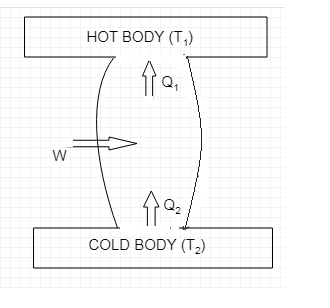
Draw schematic diagram of a refrigerator. Define its coefficient of performance and mention the expression.
Answer
558.3k+ views
Hint: A device which takes heat from a cold body and transfers it to a hot body is called a refrigerator. It does the reverse of a heat engine. Work by the external agent must be done so that the process of refrigeration goes on. First we will draw the schematic diagram of a refrigerator and from that we will define the coefficient of performance of the refrigerator.
Complete answer:
The schematic diagram of a refrigerator is shown below.

As we can see from the diagram it takes ${{Q}_{2}}$ amount of heat from the cold body which is at a lower temperature of ${{T}_{2}}$. $W$ amount of work is done by the external agent and a total of
${{Q}_{1}}={{Q}_{2}}+W$ amount of heat is given to the hot body which is at a higher temperature of ${{T}_{1}}$.
The purpose of a refrigerator is to remove as much heat from the cold body at the expense of as little work required to run the refrigerator. Thus the coefficient of performance $K$ of a refrigerator is defined as the ratio of the heat taken from the cold body to the amount of work required to run the refrigerator, Thus
$K=\dfrac{{{Q}_{2}}}{W}$.
Now
$\begin{align}
& {{Q}_{1}}={{Q}_{2}}+W \\
& or\dfrac{W}{{{Q}_{2}}}=(\dfrac{{{Q}_{1}}}{{{Q}_{2}}}-1) \\
\end{align}$
Now as in Carnot’s engine, if we use ideal gas as a working substance then it can be shown
$\dfrac{{{Q}_{1}}}{{{Q}_{2}}}=\dfrac{{{T}_{1}}}{{{T}_{2}}}$, thus
$\dfrac{W}{{{Q}_{2}}}=(\dfrac{{{T}_{1}}}{{{T}_{2}}}-1)=(\dfrac{{{T}_{1}}-{{T}_{2}}}{{{T}_{2}}})$
Therefore the coefficient of performance
$K=\dfrac{{{Q}_{2}}}{W}=\dfrac{{{T}_{2}}}{{{T}_{1}}-{{T}_{2}}}$
Note:
A refrigerator can have a coefficient of performance greater than 1. In a heat engine, heat cannot be fully converted to work, similarly a refrigerator cannot work without some external work done on the system i.e. the coefficient of performance cannot be infinite. A good refrigerator should have its value around 5 or 6.
Complete answer:
The schematic diagram of a refrigerator is shown below.

As we can see from the diagram it takes ${{Q}_{2}}$ amount of heat from the cold body which is at a lower temperature of ${{T}_{2}}$. $W$ amount of work is done by the external agent and a total of
${{Q}_{1}}={{Q}_{2}}+W$ amount of heat is given to the hot body which is at a higher temperature of ${{T}_{1}}$.
The purpose of a refrigerator is to remove as much heat from the cold body at the expense of as little work required to run the refrigerator. Thus the coefficient of performance $K$ of a refrigerator is defined as the ratio of the heat taken from the cold body to the amount of work required to run the refrigerator, Thus
$K=\dfrac{{{Q}_{2}}}{W}$.
Now
$\begin{align}
& {{Q}_{1}}={{Q}_{2}}+W \\
& or\dfrac{W}{{{Q}_{2}}}=(\dfrac{{{Q}_{1}}}{{{Q}_{2}}}-1) \\
\end{align}$
Now as in Carnot’s engine, if we use ideal gas as a working substance then it can be shown
$\dfrac{{{Q}_{1}}}{{{Q}_{2}}}=\dfrac{{{T}_{1}}}{{{T}_{2}}}$, thus
$\dfrac{W}{{{Q}_{2}}}=(\dfrac{{{T}_{1}}}{{{T}_{2}}}-1)=(\dfrac{{{T}_{1}}-{{T}_{2}}}{{{T}_{2}}})$
Therefore the coefficient of performance
$K=\dfrac{{{Q}_{2}}}{W}=\dfrac{{{T}_{2}}}{{{T}_{1}}-{{T}_{2}}}$
Note:
A refrigerator can have a coefficient of performance greater than 1. In a heat engine, heat cannot be fully converted to work, similarly a refrigerator cannot work without some external work done on the system i.e. the coefficient of performance cannot be infinite. A good refrigerator should have its value around 5 or 6.
Recently Updated Pages
Why are manures considered better than fertilizers class 11 biology CBSE

Find the coordinates of the midpoint of the line segment class 11 maths CBSE

Distinguish between static friction limiting friction class 11 physics CBSE

The Chairman of the constituent Assembly was A Jawaharlal class 11 social science CBSE

The first National Commission on Labour NCL submitted class 11 social science CBSE

Number of all subshell of n + l 7 is A 4 B 5 C 6 D class 11 chemistry CBSE

Trending doubts
What is meant by exothermic and endothermic reactions class 11 chemistry CBSE

10 examples of friction in our daily life

One Metric ton is equal to kg A 10000 B 1000 C 100 class 11 physics CBSE

1 Quintal is equal to a 110 kg b 10 kg c 100kg d 1000 class 11 physics CBSE

Difference Between Prokaryotic Cells and Eukaryotic Cells

What are Quantum numbers Explain the quantum number class 11 chemistry CBSE




